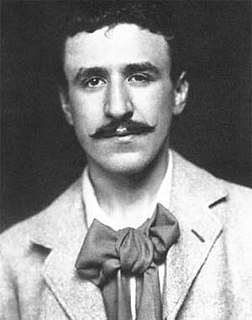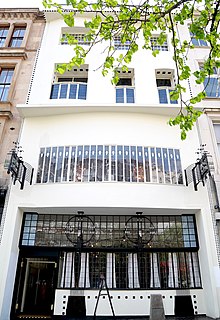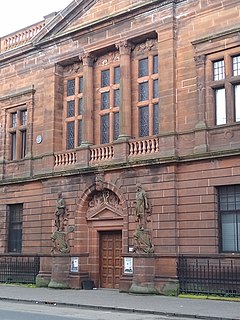
Charles Rennie Mackintosh was a Scottish architect, designer, water colourist and artist. His artistic approach had much in common with European Symbolism. His work, alongside that of his wife Margaret Macdonald, was influential on European design movements such as Art Nouveau and Secessionism and praised by great modernists such as Josef Hoffmann. Mackintosh was born in Glasgow and died in London. He is among the most important figures of Modern Style.

Inverclyde is one of 32 council areas used for local government in Scotland. Together with the East Renfrewshire and Renfrewshire council areas, Inverclyde forms part of the historic county of Renfrewshire, which currently exists as a registration county and lieutenancy area – located in the west central Lowlands. It borders the North Ayrshire and Renfrewshire council areas, and is otherwise surrounded by the Firth of Clyde.

Kilmacolm is a village and civil parish in the Inverclyde council area, and the historic county of Renfrewshire in the west central Lowlands of Scotland. It lies on the northern slope of the Gryffe Valley, 7+1⁄2 miles southeast of Greenock and around 15 miles (24 km) west of the city of Glasgow. The village has a population of around 4,000 and is part of a wider civil parish which covers a large rural hinterland of 15,000 hectares containing within it the smaller settlement of Quarrier's Village, originally established as a 19th-century residential orphans' home.

Queen's Cross Church is a former Church of Scotland parish church in Glasgow, Scotland. It is the only church designed by Charles Rennie Mackintosh to have been built; hence, it is also known as The Mackintosh Church.

James Herbert MacNair, was a Scottish artist, designer and teacher whose work contributed to the development of the Modern Style during the 1890s.

Blythswood Hill, crowned by Blythswood Square, is one of the central hills overlooking the River Clyde, which form the city of Glasgow, Scotland. It was developed as one of the city's prestigious residential areas from 1800 onwards, being known then as ″the magnificent New Town of Blythswood″.

The Willow Tearooms are tearooms at 217 Sauchiehall Street, Glasgow, Scotland, designed by internationally renowned architect Charles Rennie Mackintosh, which opened for business in October 1903. They quickly gained enormous popularity, and are the most famous of the many Glasgow tearooms that opened in the late 19th and early 20th century. The building was fully restored, largely to Mackintosh's original designs, between 2014 and 2018. It was re-opened as working tea rooms in July 2018 and trades under the name "Mackintosh at The Willow". This follows a trademark dispute with the former operator of The Willow Tearooms which was resolved in 2017. This name is now used at tea room premises in Buchanan Street and was also additionally used at the Watt Brothers Department Store in Sauchiehall Street, Glasgow between 2016 and its closure in 2019.

Hippolyte Jean Blanc was a Scottish architect. Best known for his church buildings in the Gothic revival style, Blanc was also a keen antiquarian who oversaw meticulously researched restoration projects.
Sir John Mackintosh MacLeod, 1st Baronet was a Scottish MP for the Unionist Party. He sat for Glasgow Central from a by-election in 1915 to 1918, and for Glasgow Kelvingrove from 1918 to 1922. He was elected in 1918 as a supporter of David Lloyd George's coalition government.

Sir George Washington Browne was a British architect. He was born in Glasgow, and trained there and in London. He practiced mainly in Edinburgh, where he designed a number of large public and commercial buildings, although his work is found throughout Scotland and Britain.

James Sellars was a Scottish architect who was heavily influenced by the work of Alexander Greek Thomson.

William Leiper FRIBA RSA (1839–1916) was a Scottish architect notable particularly for his domestic architecture in and around the town of Helensburgh. In addition, he produced a small amount of fine ecclesiastical and commercial architecture in Glasgow and the Scottish Lowlands. He was also an accomplished watercolour artist, and from the late 1870s spent much spare time painting in oils and watercolours.

The Fairfield Heritage Centre is situated on Govan Road, Glasgow, Scotland. Built as the offices of Fairfield Shipbuilding and Engineering Co Ltd between 1889-1891 the building was used as the principal offices for successive owners of the adjacent shipyard until 2001, when it was vacated by BAE Systems Marine. After deteriorating unused for 8 years it was bought by social enterprise charity Govan Workspace in 2009. Following a restoration costing over £5.8m it was re-occupied as a heritage centre and commercial offices in 2013.

Archibald Campbell Douglas was a Scottish architect based primarily in Glasgow. He designed many churches in Glasgow and Edinburgh, especially those for the Free Church of Scotland.
Pettigrew & Stephens was a department store based in Sauchiehall Street, Glasgow.

John Keppie was a Glasgow architect and artist. From an early age he was a close friend of Edward Atkinson Hornel and would often bring in New Year with him in Kirkcudbright. Within the architectural profession, he was closest to John Archibald Campbell, and is credited with training Charles Rennie Mackintosh.

John Starforth (1822-1898) was an English-born architect and architectural author associated solely with work in Scotland, mainly working in Lothian, Dumfries & Galloway, and the Scottish Borders.
Hugh Barclay (1829–1892) and David Barclay FRIBA (1846–1917) were Scottish architects operating in the late 19th and early 20th centuries under the name of H & D Barclay. They specialised in the design of schools and colleges, but also did considerable municipal and church work.
Peter MacGregor Chalmers LLD was a Scottish architect specialising in country churches, and also being involved in several important restoration schemes.

John Honeyman was a Scottish architect. He designed several notable buildings in Scotland, mostly churches, and worked alongside Charles Rennie Mackintosh as a partner for several years.
















